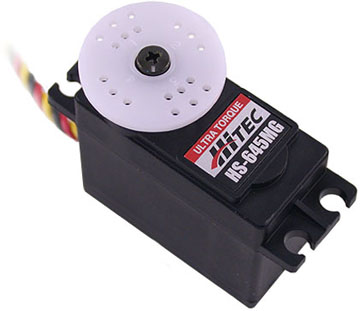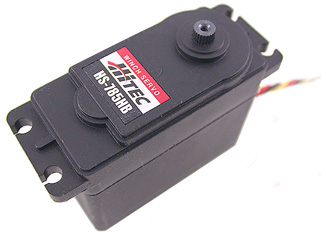Talk:Servomechanisms (aka "Servos")
The E-2? Robot project has currently adopted two types of servomechanisms to drive its mechanical parts.
HS-645MG:
this is the smaller one, with 90° shaft rotation (in the simplest configuration) or 180° with a special RC controller or using Hitec's servo stretcher.
HS-785HB; this is the bigger one, with shaft angular movement ranging from (-360°*2.5) to (-360°*2.5), two complete turns and a half per direction.
Here we describe how we've tried to assess the continuous torque of HS-645MG.
Hitech gives a generic torque specification on the box of their servos and on their internet site - contacted by us, one of Hitec's service managers wrote that the torque on the spec denotes the "stall torque" and to assume its 80 percent as continuous torque.
In order to test our servos we have done the following:
- opened the case of our servo and fitted a thermocouple near the circuitry, then closed it back
- mounted a horn on the shaft, then attached a wire at a known distance from the horn's center, using the farthest hole available on the horn. The wire's end will be used to apply a force, which, using the horn as the lever's arm, will create the desired moment on the shaft
- arranged some objects (like bottles filled with water, wired together) with adjustable mass: their final weight, divided by the length of the winch's arm (19mm in our case) will equal the tested torque.
And we have assumed this:
- we can apply a moment using a single force at an arm's end, thereby obtaining something different from a "pure" torque: our force induces rotation and translation, while a pure torque (a couple) causes only rotation.
-
- in the context of our robot's functioning, a mere 10 minute's test time should be enough to characterize the tested torque as "continuous". In fact we may prevent prolonged stress for our servos via behavior rules - the basis for this is that we see no reason to keep the body in a completely bent configuration for more than a minute or two (VERIFY THIS).
So we've started our test, using Hitec's specification of continuous torque (76.80 kgf*mm) as initial guess, and we've seen the measured temperature rising rapidly from 35° to 40° in the first three or four minutes of our test, so we've decided to abort this test, guessing that the actual temperature in the machinery/circuitry of our servo could be higher.
We've prepared a second run with a lower torque (59.19 kgf*mm) and this time we've reached the same high temperature in 10 minutes, thereby deciding to adopt this second value as a better estimate of the "continuous" torque.



